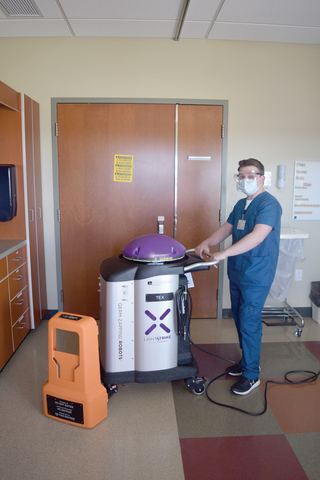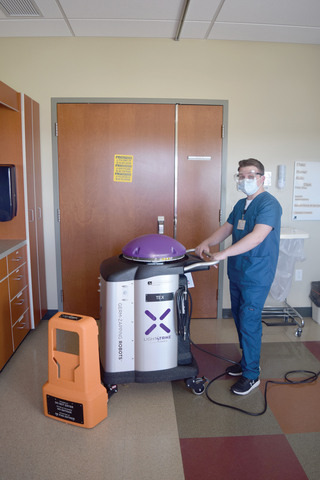BURNS, Ore.--(BUSINESS WIRE)--Germs, beware! Harney District Hospital, a Critical Access facility serving residents living in rural communities across Harney County, today announced it has added two LightStrike Germ-Zapping Robots to its cleaning and disinfection protocols. Armed with this new technology, the hospital’s Environmental Services (EVS) team is ready to destroy deadly pathogens that the naked eye can’t see.
The automated room disinfection devices are pathogen assassins, and they recently joined HDH’s EVS team in the fight against viruses and bacteria. As hospitals look for new and innovative ways to stop the spread of germs, HDH has taken high-tech measures with the deployment of LightStrike room disinfection robots manufactured by Xenex Disinfection Services, the world leader in UV disinfection for healthcare facilities.
“The robots are a great addition to HDH’s EVS team. While EVS has always followed comprehensive policies and procedures when cleaning the hospital, it is an added comfort knowing that the robots’ intense UV light technology destroys microscopic germs we may have missed on doorknobs, floors, and other high-touch surfaces in the room,” EVS Manager Kathy Byram said.
The COVID-19 pandemic has people very aware of the threat of dangerous pathogens. Some viruses and bacteria are becoming resistant to cleaning chemicals, antibiotics, and even hand sanitizers, so forward-thinking hospitals like HDH are turning to new technology to enhance their cleaning and sanitation practices. LightStrike robots use pulsed xenon to create intense bursts of powerful ultraviolet (UV) light that quickly destroy bacteria, viruses, and spores on surfaces. The robots work quickly and do not require warm-up or cool-down time, so EVS staff are able to disinfect a number of rooms each day.
Viruses and bacteria are vulnerable to UV light at various wavelengths. The broad spectrum UV light emitted by a LightStrike robot hits pathogens where they are most vulnerable. The robots have been proven effective against the most common — as well as the most dangerous — pathogens, including SARS-CoV-2, influenza, MRSA, and C.diff. More than 45 peer-reviewed studies have been published by healthcare facilities validating the efficacy of the LightStrike robot technology. The robots are proven to deactivate SARS-CoV-2, the virus that causes COVID-19, in 2 minutes.
The portable LightStrike robots run in 5-minute cycles. Operated by HDH’s EVS team, the robots can be used in the hospital and clinics, including isolation rooms, operating rooms, general patient care rooms, contact precaution areas, emergency rooms, offices, conference rooms, restrooms, and more.
Use of the LightStrike robots enhances the hospital’s already thorough processes for cleaning rooms and destroying dangerous pathogens. The robots are part of the EVS team and did not replace any employees.
“To destroy viruses that may be lurking in a room, the EVS team will set up a robot in a discharged room before we clean it,” Byram said, explaining that this is an extra precaution to kill viruses and bacteria in the room before the EVS staff enters it. “After the robot has shut off, we will go in and clean the room following our policies and procedures.”
Byram noted that this enhanced process is embraced by the EVS team, as they understand and appreciate that the disinfection and cleaning practices are directed toward providing the cleanest possible environment for the benefit of patients as well as employees and their families.
After the robots have completed their disinfection cycle, a typical room cleaning process takes place. All visible dirt/fluids are removed, trash is emptied, linens are removed, etc. Once the room is visually clean, EVS staff runs the robot again.
For more information, visit harneydh.com or xenex.com.




